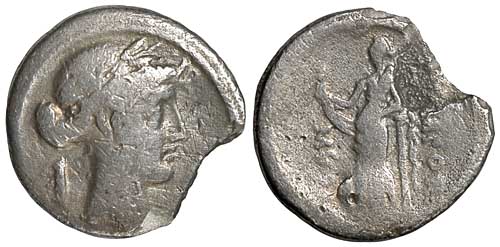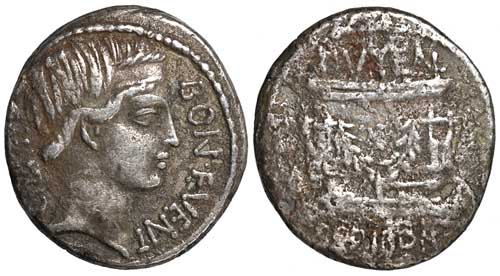| <— Last coin | ---------- What I Like About Ancient Coins ---------- | Next coin —> |

|

|
 |
Coin Type: Silver denarius of L. Scribonius Libo, Roman Republic, 62 BCE Mint and Date: Rome, 62 BCE. Size and Weight: 18mm x 19mm, 3.7g Obverse: BON EVENT LIBO Diademed head of Bonus Eventus. Reverse: PVTEAL SCRIBON The Puteal Scribonarium (well head), ornamented with garland between two lyres and hammer at base. Provenance: Vaughn Rare Coin Gallery (Vcoins), November 2005 Ref: RCV (2000) 367; RSC Scribonia 8. BW Ref: 018 024 066 |
| Click on the picture for a larger scale view of the coin | |
|
Note: From "A Dictionary of Roman Coins ": PUTEAL —In the comitium, or place of popular assembly, at Rome, there is said to have been a spot, on which a statue of Accius Nævius (of Tarquinius Priscus' time) was placed, because there the celebrated augur was said to have severed, or caused the above-named king to sever, the whetstone with a razor. Under this statue there was (according to Dionysius Halicarnassus) a subterranean cavity, called puteus (a well or pit), in which beneath an altar, the whetstone of Accius was deposited; over the well a cover was placed, whence it derived its name of Puteal. But when the place fell into decay, Scribonius Libo, by order of the senate, caused it to be restored, which led to its being called PVTEAL SCRIBONII, as certain denarii show. —According to Beger's opinion, this covering to the well was called LIBO, because that person (see the Scribonia family) lived in the vicinity, or because it was erected or repaired at his expense. Thus Horace would seem to infer (lib. 1. ep. xix. 1. 8) Forum Putealque Libonis It was, however, not the tribunal itself, but only the neighbourhood of the tribunal. —One of the numerous opinions subsiisting, as well among ancient authors as among modern commentators, respecting this place, so often allluded to in Roman history, is this, that on some occasion or other, lightning had fallen upon it, and that in consequence a covered well was constructed there, under authority, by the functionary whose name it bears. Be this as it may, it seems agreed on all hands that the Puteal of Libo was much frequented, as a sort of exchange, by the commercial and banking classes of Rome —see Scribonia. Spanheim (Pr. ii, p. 189) contends that the Puteal Libonis or Scribonii ought not to be confounded with the one constructed in the comitium, to which Cicero refers. The object represented on medals of the Aemilia and Scribonia families looks more like an altar adorned with sculptured flowers than the tribunal or seat of a praetor. But the whole matter remains involved in obscurity, and is too much associated with fabulous history, and too little with events of any importance, to repay or deserve the learned researches and conjectures which have been bestowed on it. (under Scribonia:) The Puteal of Libo, a celebrated place in Rome, was the round parapet of a wall with a cover to it, which Scribonius Libo had caused to be raised, by order of the senate, over a place where thunder had fallen, in the field of the Comitia, and near the statues of Marsyas and Janus. It contained within its enclosure an altar and a chapel. It seems, moreover, that it was a kind of tribunal or seat of justice, like our Court of Common Pleas. | |
| The content of this page was last updated on 6 March 2006 |